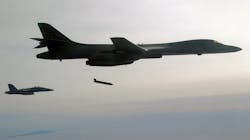Lockheed Martin to build sophisticated air-to-surface missiles and guidance in deals worth $843.7 million
EGLIN AIR FORCE BASE, Fla. – Missile experts at Lockheed Martin Corp. will build two kinds of sophisticated air-to-surface missiles for the U.S. Air Force under terms of two contracts announced Monday collectively worth $843.7 million.
Officials of the Air Force Life Cycle Management Center at Eglin Air Force Base, Fla., are asking the Lockheed Martin Missiles and Fire Control segment in Orlando, Fla., to build 400 of the Joint Air-to-Surface Standoff Missile-Extended Range (JASSM-ER), and 137 of the Long-Range Anti-Ship Missile (LRASM).
The JASSM-ER contract is worth $428.4 million over four years and involves lot 19 production. It includes containers, training, production preparation, tooling, test equipment, and spare parts. The LRASM contract is worth $414.3 million over four years and includes tooling and test equipment.
JASSM-ER is a 2,250-pound cruise missile with a 1,000-pound penetrator and blast-fragmentation warhead. It uses precision routing and guidance in adverse weather, day or night, using an infrared seeker in addition to the anti-jam GPS to find a specific aim point on the target.
JASSM, which has been in service since 2009, is a long-range, conventional, air-to-ground, precision standoff missile for the U.S. and allied forces that is designed to destroy high-value, well-defended, fixed and relocatable targets. The JASSM has a range of 230 miles, while the JASSM-ER has a range of 620 miles.
The stealthy JASSM missiles have significant standoff ranges to keep air crews well out of danger from hostile air defense systems, while their stealthy airframes makes the smart munitions extremely difficult to defeat, Lockheed Martin officials say.
JASSM can be fired from several different aircraft, including the B-1, B-2, B-52, F-16, F/A-18E/F, and F-15E. International JASSM users include the Australian, Finnish, and Polish air forces.
Looking to the future, Lockheed Martin is working on the JASSM to enable the missile to fire from U.S. and international versions of the Lockheed Martin F-35 Lightning II joint strike fighter aircraft and other international military aircraft.
LRASM is a joint project of the U.S. Defense Advanced Projects Agency (DARPA) in Arlington, Va., the Navy, and the Air Force to design an advanced anti-ship missile that can launch from the Navy F/A-18E/F Super Hornet jet fighter bomber, as well as from the Air Force B-1B Lancer long-range strategic bomber.
In the future LRASM also will launch from the F-35 and from the Navy Mark 41 shipboard Vertical Launch System. The missile travels at high subsonic speeds, and likely will give way in the future to expected new generations of hypersonic missiles. Submarine-launched versions are under consideration.
LRASM is designed to detect and destroy high-priority targets within groups of ships from extended ranges in electronic warfare jamming environments. It is a precision-guided, anti-ship standoff missile based on the Lockheed Martin Joint Air-to-Surface Standoff Missile-Extended Range (JASSM-ER).
Lockheed Martin has been designing LRASM for the last 12 years, primarily under DARPA supervision. The advanced anti-ship missile is intended to replace the ageing Harpoon anti-ship missile. It has a multi-mode radio frequency sensor, a new weapon data-link and altimeter, and an uprated power system.
The LRASM can be guided toward enemy ships from as far away as 200 nautical miles by its launch aircraft, can receive updates via its datalink, or can use onboard sensors to find its target. LRASM will fly towards its target at medium altitude then drop to low altitude for a sea skimming approach to counter shipboard anti-missile defenses.
The LRASM uses on-board targeting systems to acquire the target independently without the presence of intelligence or supporting services like Global Positioning System (GPS) satellite navigation and data links. Lockheed Martin is designing he missile with advanced counter-countermeasures to evade hostile active defense systems.
The Lockheed Martin LRASM has a 1,000-pound penetrator and blast-fragmentation warhead, multi-mode sensor, weapon data link, and enhanced digital anti-jam global positioning system to detect and destroy selected surface targets within groups of ships.
Lockheed Martin is in charge of LRASM overall development, and the BAE Systems Electronic Systems segment in Nashua, N.H., is developing the LRASM onboard sensor systems.
On the JASSM-ER contract Lockheed Martin will do the work in Orlando, Fla., and will be finished by July 2025. On the LRASM contract the company will do the work in Orlando, Fla., and Troy, Ala., and should be finished by March 2025.
For more information contact Lockheed Martin Missiles and Fire Control online at www.lockheedmartin.com, or the Air Force Life Cycle Management Center at www.aflcmc.af.mil.

John Keller | Editor-in-Chief
John Keller is the Editor-in-Chief, Military & Aerospace Electronics Magazine--provides extensive coverage and analysis of enabling electronics and optoelectronic technologies in military, space and commercial aviation applications. John has been a member of the Military & Aerospace Electronics staff since 1989 and chief editor since 1995.

